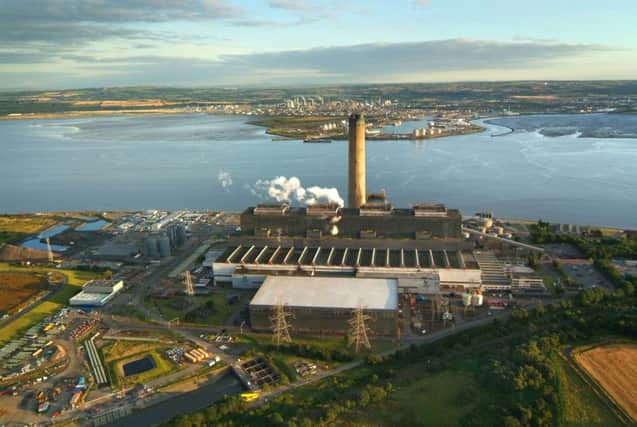Scott Macnab: SNP struggling to keep Scotland's lights on


How would an independent Scotland keep the lights on? The row over the multi-billion pound renewal of the Hinkley Point nuclear power station will have just as much impact on Scotland as the rest of the UK after a series of recent blows to Scotland’s energy industry. The disappearance of the Longannet and Cockenzie power plants has left the SNP regime ever more reliant on nuclear energy generation which it demonises. The renewables revolution is never likely to be enough to meet all of the country’s energy demands, particularly heat. Hinckley, despite the SNP’s qualms, will be as vital to keeping us in power as it is elsewhere in the UK.
The closure of the massive Longannet coal-fired plant on the banks of the Forth in March, after more than four decades of operation, brought the coal age to an end in Scotland. The switch-off and loss of almost 300 high-quality jobs sent shockwaves across the country. The plant had contributed more energy to the UK national grid than any other power station in Scotland’s history and its early closure provided a wake-up call for the country just as decades of plentiful North Sea oil and gas supplies began to dwindle.
Advertisement
Hide AdAdvertisement
Hide AdThe closure of Cockenzie in East Lothian, three years earlier, which powered approximately a million Scottish homes during its 45-year lifespan, marked another sad milestone in our history as an industrial-scale energy generator. Environmentalists welcomed the demise of these facilities as a timely nail in the coffin of “dirty” coal energy. Plans had already been put in place by the UK government – since hastily revised – to end coal generation by the mid 2020s. But the Longannet situation also prompted claims from the SNP government, and the plant’s owners, Scottish Power, that the “prohibitive” cost of generating energy in Scotland and then effectively “plugging” into the UK national grid was the problem, as well as the growing green taxes.
But the SNP government’s shortcomings also came under fire. One of the earliest engagements Alex Salmond undertook after becoming First Minister in 2007 was a trip to Longannet to hail £1 billion of upgrades from ScottishPower, cementing a notably cosy relationship between the SNP leader and Ignacio Galan, head of its parent firm Iberdrola. Then, just six months before Salmond’s landslide 2011 election victory, he welcomed a £2.7bn Iberdrola investment in Scottish firms. A few years later all that Scots seemed to notice was the Spanish giant presiding over the demise of its two major power stations in the country. On top of this, the Torness and Hunterston nuclear plants, making up a third of our electricity needs, are poised to close within a decade.
Instead, wind energy was hailed as the way ahead for Scotland, with Salmond proclaiming that Scotland’s offshore potential could make it the “Saudi Arabia of renewables”. Fast forward a few years and we hear stark warnings this week that Scotland’s hopes of being a world leader in this field could collapse after a flagship £9bn windfarm off the coast of Dundee was sunk by the Court of Session amid concerns over the impact on bird life. It leaves Scotland with just two viable offshore projects – compared with 29 in England and Wales. And although windfarms now pepper vast swathes of Scotland’s countryside, future developments have been plunged into doubt after the UK government axed lucrative subsidies. It is worth remembering that although Scotland accounts for about 10 per cent of electricity sales in the UK, at the time of the last Scottish referendum we had received 28 per cent (£560 million) of subsidies.
There have been warnings in recent years from energy regulator Ofgem and others about UK blackouts as energy demand exceeds the crucial “reserve margin” which is being held by the National Grid. A couple of winters back this shrunk to a fraught 1.2 per cent of extra capacity to cover peak UK demand of about 54 gigawatts. It was only an “emergency” system to fire up mothballed plants and also pay firms to turn down their power use at peak times which kept the lights on. But security of supply will continue to be a major fear for the UK without new power stations. Scots faced a stark warning last year from Professor Gary Pender, head of the Institute of Civil Engineers in Scotland, that the country is on course to become a net importer of energy from England, after decades as a net exporter, without new plants. And with the new Hinckley Point poised to produce 7 per cent of the UK’s overall energy needs, its significance cannot be underplayed.
If Prime Minister Theresa May has serious security concerns over China’s central role in the project, that’s an issue which should rightfully be explored. But if it is simply an issue of Chinese money and involvement in a key British infrastructure project, it does somewhat smack of slamming shut the stable door after the horse has long ago bolted.
Former Chancellor George Osborne, like Salmond, was assiduous in courting Beijing investment. As well as major stakes in UK institutions like Barclays and BP, China has also invested billions in London and the proposed Northern Powerhouse projects. In Scotland, a memorandum of understanding with Chinese consortium SinoFortone paved the way for investment in housing and rail projects worth up to £10bn. Scottish universities would be plunged into a major funding crisis without the lucrative international fees provided 7,500 Chinese students at our universities.
So Hinckley Point is just as important for Scotland’s energy needs as the rest of the UK. And as another independence referendum is mooted, the SNP should bear in mind the UK government’s warning in 2014 that the current integrated GB energy system could not continue if Scotland left the UK. It should throw into sharp focus the shape of Scotland’s energy future before the lights start to flicker.